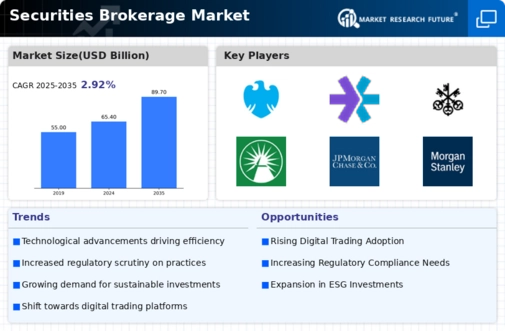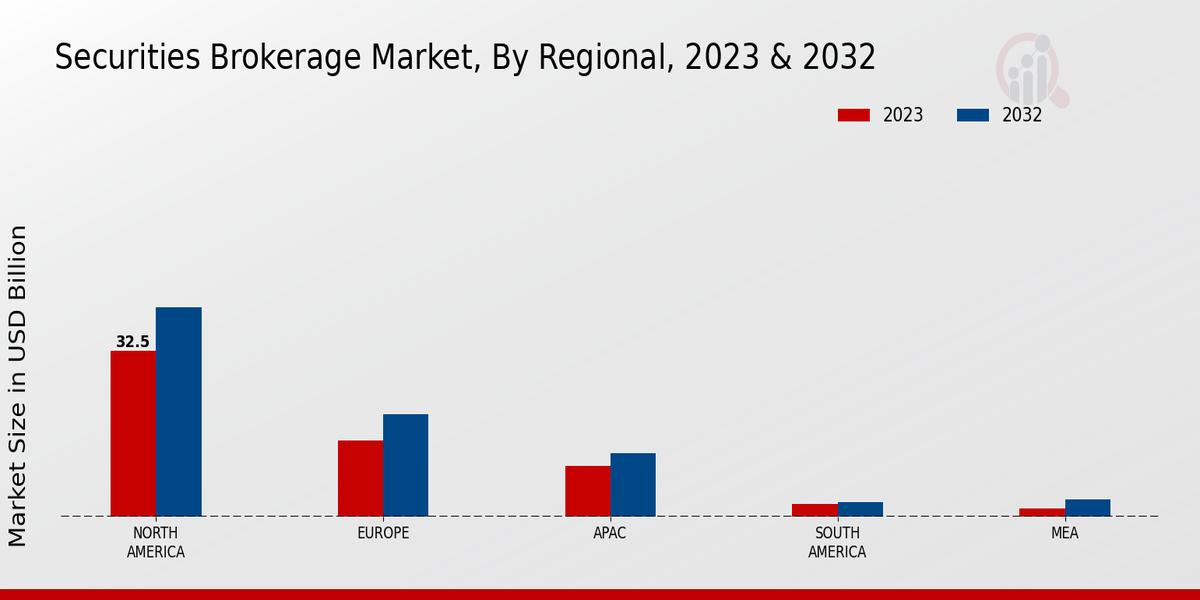Regulatory Changes
Regulatory changes play a pivotal role in shaping the Global Securities Brokerage Market Industry. Governments and regulatory bodies worldwide are continuously updating policies to enhance market transparency and protect investors. These regulations often lead to increased compliance costs for brokerage firms, but they also create opportunities for growth by fostering investor confidence. For example, the implementation of MiFID II in Europe has led to a more structured trading environment, encouraging more participants to enter the market. This regulatory landscape is expected to contribute to the market's growth, with projections indicating a rise to 89.7 USD Billion by 2035.
Global Economic Growth
Global economic growth is a significant driver of the Global Securities Brokerage Market Industry. As economies expand, corporate earnings tend to rise, leading to increased investment activities. This growth encourages both institutional and retail investors to engage in securities trading, thereby boosting brokerage revenues. For instance, emerging markets are experiencing rapid economic development, which is attracting foreign investments and enhancing market liquidity. Consequently, the Global Securities Brokerage Market is expected to benefit from this economic momentum, with forecasts indicating a market size of 65.4 USD Billion in 2024, as investors seek opportunities in a thriving economic environment.
Market Growth Projections
The Global Securities Brokerage Market Industry is poised for substantial growth in the coming years. Projections indicate that the market will reach 65.4 USD Billion in 2024, with a steady increase anticipated as investor confidence and participation rise. The market is expected to experience a CAGR of 2.92% from 2025 to 2035, driven by various factors including technological advancements, regulatory changes, and increasing investor participation. This growth trajectory suggests a robust future for the industry, as brokerage firms adapt to evolving market dynamics and consumer preferences.
Technological Advancements
The Global Securities Brokerage Market Industry is experiencing a transformative phase driven by rapid technological advancements. Innovations such as algorithmic trading, artificial intelligence, and blockchain technology are reshaping the landscape of securities brokerage. These technologies enhance trading efficiency, reduce transaction costs, and improve customer experience. For instance, the integration of AI in trading platforms allows for real-time data analysis and predictive analytics, enabling brokers to make informed decisions swiftly. As a result, the market is projected to reach 65.4 USD Billion in 2024, reflecting the growing reliance on technology in brokerage services.
Increasing Investor Participation
The Global Securities Brokerage Market Industry is witnessing a surge in investor participation, particularly among retail investors. This trend is fueled by the proliferation of online trading platforms and mobile applications that make investing more accessible. As more individuals seek to manage their own investments, brokerage firms are adapting their services to cater to this growing demographic. The rise of social trading and investment communities further encourages participation, as novice investors can learn from experienced traders. This influx of new investors is likely to drive market growth, contributing to a projected CAGR of 2.92% from 2025 to 2035.
Shift Towards Sustainable Investing
The Global Securities Brokerage Market Industry is increasingly influenced by the shift towards sustainable investing. Investors are becoming more conscious of environmental, social, and governance (ESG) factors, prompting brokerage firms to offer products that align with these values. This trend is not only reshaping investment strategies but also creating new market opportunities for brokers who can provide ESG-compliant investment options. As a result, the demand for sustainable investment products is expected to rise, contributing to the overall growth of the market. By 2035, the market is projected to reach 89.7 USD Billion, reflecting this growing emphasis on sustainability.















